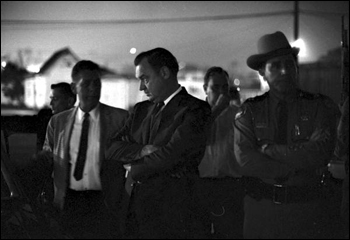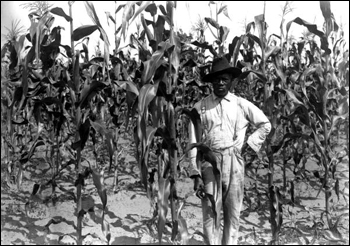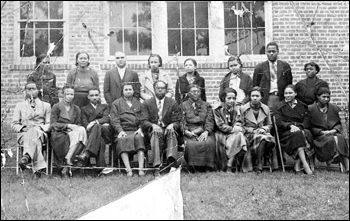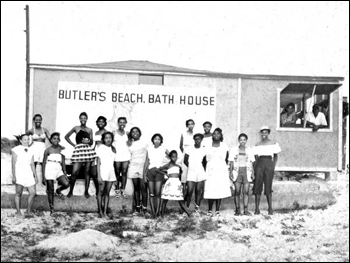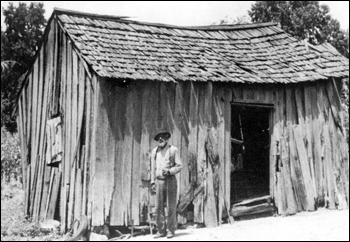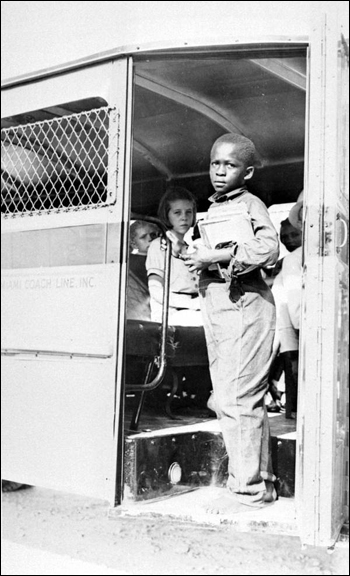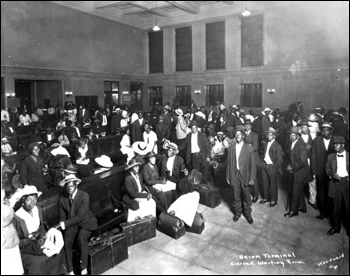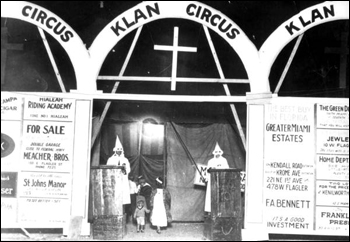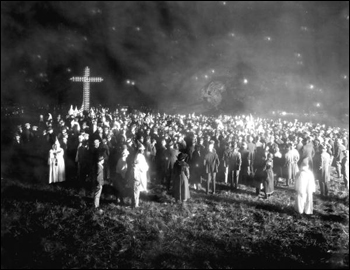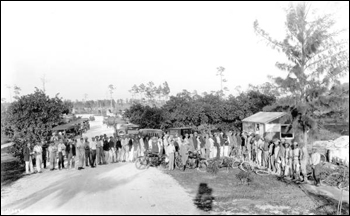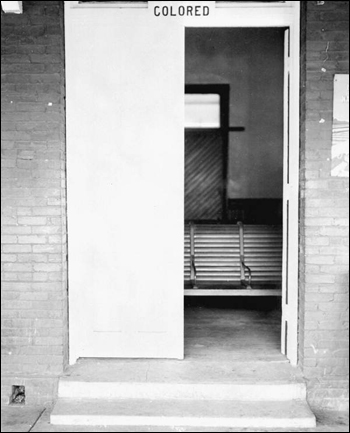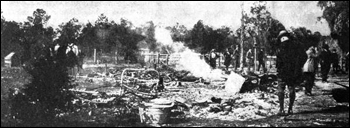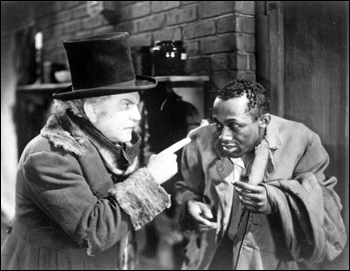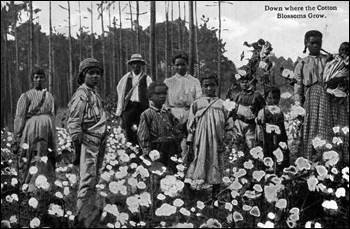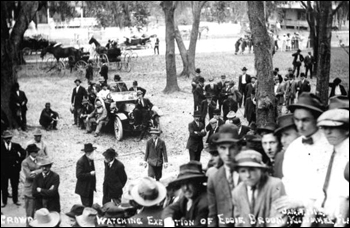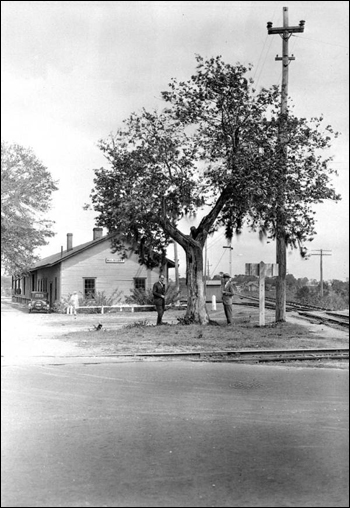Photo Exhibits
Photo exhibits spotlight various topics in Florida history, and are accompanied by brief text intended to place selected materials in historical context.
Racism and the Struggle for Civil Rights in Florida
Florida During American Racial Segregation
On the night of April 4, 1968, Leon County Sheriff William P. Joyce and Florida Governor Claude Kirk stood in the streets of the state capital. Hours before, Reverend Dr. Martin Luther King, Jr. had been shot and killed on the balcony of the Lorraine Motel in Memphis, Tennessee.
When the Florida Agricultural and Mechanical University (FAMU) campus heard the news of the assassination of Dr. King, student protests broke out in the quads. Day turned into night as protests escalated into bottle throwing at passing cars and small car fires in the streets of Tallahassee. For the 10 days following the civil rights leader's death, riots broke out in over 100 American cities from San Francisco to New York, Chicago to New Orleans. Race relations in the United States had taken front and center in the public square.
This exhibit of images from the Florida Memory Photographic Collection illustrates a brief history of racism and the struggle for civil rights in Florida.
Governor Claude Kirk during Tallahassee riots following the assassination of Dr. Martin Luther King, Jr. (April 4, 1968)
Image number: C800000-114
Left to Right: Sheriff William P. Joyce, Governor Kirk, unidentified highway patrolman.
Accompanying note: "On April 4, 1968, James Earl Ray assassinated Dr. Martin Luther King, Jr., civil rights activist and Nobel Peace Prize winner, in Memphis, Tennessee. In the ten days following this tragic event, riots erupted in over one hundred American cities. Up until this time, social scientists believed all rioting occurred in response to local events or dissatisfaction. This assassination proved that black awareness extended further than home boundaries. The rioting afterwards 'was the first time that [Black] collective disorder was set off in response to a single, politically significant national event.'"
Nearly a century before the modern Civil Rights Movement, the Civil War pushed the nation into a new era ending legal human bondage. During the period of Reconstruction after the Civil War, laws were created to protect the rights of former slaves and for the first time, all African-Americans were legally permitted to own land, go to school, and run businesses.
African-American farmer standing in corn field: Alachua County, Florida (June 25, 1913)
Image number: RC13671
Stevens school faculty (193-)
Image number: PR03569
Back, Left to Right: Polly Preston Simms, Rachel Williams, Arthur Jones, Irene Caldwell, Eloise Anderson, Winifred Harden, B.B. (Bernard) Crowder, Veresta Wilson (daughter of Henrietta).
Front: T.L. Sherman, Annie Ruth Henderson Jackson, Robert Stevens (son of Dr. William Stevens and Annie Kent Stevens), Mrs. Lucy Smith, Lasalle Lefall, principal; Sarah Bennett, Hazel King, Inez Stevens Jones, Minerva Laster, Genevieve Lowe
Beach-goers assembled for a group portrait by the bath house at Butler Beach: Anastasia Island, Florida (195-)
Image number: RC12411
After being developed as a recreational area by prominent local African-American businessman and entrepreneur, Frank B. Butler, Butler Beach was the only beach African-Americans were allowed to use between Jacksonville and Daytona Beach. Butler also owned a casino, inn, and other businesses, and led development of a subdivision of black-owned homes.
George Carson: Jefferson County, Florida (1937)
Image number: RC02019
Former slave, George Carson, standing by the house in which he lived after coming to Florida in 1875.
African-American school children on bus: Dade County, Florida (1937)
Image number: N029451
Reconstruction also marked the birth of the infamous white supremacy group, the Ku Klux Klan. After Reconstruction, Southern state legislators enacted laws segregating public spaces. Under "Jim Crow," as the laws came to be known, a segregated culture enforced racial discrimination and a tradition of legal and extra-legal violence emerged that terrorized African-Americans throughout the South.
Segregated waiting room at railroad depot: Jacksonville, Florida (1921)
Image number: RC09666
Klan circus (192-)
Image number: PR20293
Ku Klux Klan rally: Tampa, Florida (1923)
Image number: RC10111
Segregated pay day: Coral Gables, Florida (December 23, 1922)
Image number: RC02663
Entrance to a segregated railroad depot (May 5, 1941)
Image number: SP02735
In the decades following the Civil War, racism became firmly fixed in American culture. Literature and the new form of popular entertainment, films, celebrated the "Lost Cause" of the Confederacy and the triumph of white culture. One example was the hugely successful and innovative 1915 Hollywood film, Birth of a Nation, which was based on a best-selling novel that romanticized the origins of the KKK. Black-face minstrel shows and black humor postcards showing cut-and-pasted African-American babies in the mouths of alligators and other grotesque depictions were common.
In the first half of the century, Florida led the nation with the highest number of lynchings per capita. Mobs of unmasked white men targeted and attacked Florida's Black communities like Ocoee on November 2, 1920, and Rosewood in January of 1923. Today it's hard to understand "the feeling," as W. J. Cash wrote in The Mind of the South, "which, in time of stress, would seize control of the best almost as surely as the sorriest cracker."
Ruins of a burned African-American home: Rosewood (January 4, 1923)
Image number: RC12408
Accompanying note: "The ruins of the house near Rosewood in which 20 armed negroes fought off a band of white men searching for a negro who, it is said, had attacked a white woman."
The deliberate burning of cabins and a church wiped out the African-American quarter of Rosewood as the inhabitants escaped in to the woods.
Movie scene with Lincoln T.M.A. Perry (192-)
Image number: PR07280
Lincoln T.M.A. Perry (1902-1985) was better known as Stepin Fetchit. He was born in Key West, Florida. His screen persona is often cited as an example of unfavorable black stereotypes, although his popularity opened the door for many future black actors. He acted in 54 films, was given a star on the Hollywood Walk of Fame and a Special Image Award from the NAACP. In 1960, he became a Muslim, and befriended boxer Muhammad Ali. It is unknown what movie this image is from.
Down where the cotton blossoms grow (19--))
Image number: N029289
Crowd gathered for the execution of Eddie Broom: Kissimmee, Florida (January 19, 1912)
Image number: RC13773
Eddie Broom was convicted and hanged for the murder of Sam Boatwright, who was shot with a pistol on January 23, 1910.
G. Ponton and H. Gunter standing beneath mulberry tree: Mulberry, Florida (March 12, 1929)
Image number: GE1147
This tree is one from which public hangings in the past have taken place. Bullet holes are seen in the trunk.

 Listen: The Gospel Program
Listen: The Gospel Program